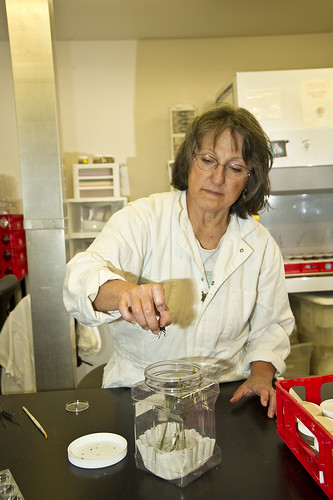
At the APHIS Otis Lab in Massachusetts, employees conduct research for several APHIS forest pest emergency response and eradication programs, including Asian longhorned beetle (ALB), Asian gypsy moth (AGM), emerald ash borer (EAB), and Sirex noctilio woodwasp.
In addition to the existing science-based eradication protocols for fighting an Asian longhorned beetle (ALB) infestation, such as surveying trees and removing infested ones, the USDA’s Animal and Plant Health Inspection Service (APHIS) relies on on-going research to not only improve current protocols, but also to develop new ones.
APHIS’s Center for Plant Health Science and Technology continues research to develop attractant-baited traps designed to lure and capture adult insects. The attractants include plant odors and pheromones, which are naturally occurring chemicals created and used by insects to communicate with each other. These attractants are used to lure beetles to traps that are hung on trees that the beetle will attack. Traps can aid in early detection of insects in areas where survey staff may not be working. When the traps are checked by staff members and a beetle is found, nearby trees may be surveyed to determine if they are infested. This year, the traps will be placed in the spring and early summer in strategic locations in all three ALB-affected states: New York, Massachusetts, and Ohio. APHIS is also working with the U.S. Forest Service and Penn State University on their research with similar ALB traps.
APHIS has a number of additional ALB-related research projects, including defining the specific wood-chipping and grinding methods needed to kill all ALB in wood from infested areas, determining if treating trees with insecticides in the fall can be as effective as the current practice of treating trees in the spring, developing treatments for nursery stock that allow it to be moved safely out of ALB-infested areas, gaining better information on ALB’s ability to attack and develop on different kinds of trees, DNA analysis, and understanding how ALB infestations grow and spread in different types of habitats. This kind of information can help the ALB program decide where to carry out key activities such as surveys and control treatments.
All ALB-related research supports the goal to eradicate the pest from the U.S. and protect hardwood forests and park lands, trees within affected communities, and many different forest product industries.
You can help. When you are outside, take a look at a tree and see if it has round holes on the trunk and/or branches – these holes are caused by the adult beetle when it exits the tree. The holes are a little bit smaller than a dime and just a bit bigger than the circumference of a pencil. You may also see an adult beetle on the tree itself or surrounding surfaces. If you see signs of ALB, please make a report online because the sooner we know about an ALB infestation, the sooner we can do something about it.
No comments:
Post a Comment
Note: Only a member of this blog may post a comment.